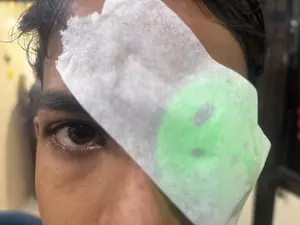21 patients, largely minors, reported at PGI Chandigarh with firecracker injuries

Chandigarh, Nov 1 Twenty-one patients, largely minors, came to the PGI’s Advanced Eye Centre here with a history of firecracker injuries in the past 48 hours, the hospital said on Friday. There were 16 males and five females.
The decline in numbers, paired with rapid intervention by specialised teams at the Postgraduate Institute of Medical Education and Research (PGIMER) reflected ongoing improvements in public awareness and swift medical readiness, it said in a statement.
Twelve of the 21 patients (57 per cent) were children less than 14 years of age. The youngest was a three-year-old girl. There were eight patients from tricity -- Panchkula and Mohali. The remaining patients were from the neighbouring states of Punjab and Haryana (four each) and Himachal Pradesh, Uttar Pradesh and Rajasthan (one each).
Twelve patients were observers or bystanders and the rest were bursting crackers themselves. The type of firecrackers included ‘tilli’ bomb, ‘putli’ bomb, sky shot, ‘bicchu’ bomb, ‘anar’, ‘aloo’ bomb and ‘phuljhari’.
Out of 21 total patients, six patients needed surgery and all have been operated upon, said the hospital.
Additionally, PGIMER’s Trauma Centre handled five burn cases related to Diwali celebrations. Among these, an 18-month-old boy suffered 30 per cent burns on his right side, and a 16-year-old girl sustained 50-55 per cent burns, predominantly on her upper body.
Both have been stabilised and are now in the Burn ICU for continued management, while the other three cases are under care and being managed accordingly for the injuries suffered.
Over the last three years, PGIMER's Advanced Eye Centre has managed Diwali-related injuries with planning and emergency protocols, showcasing consistent responsiveness to festival-related eye trauma.
In anticipation of Diwali-related injuries, PGIMER's Advanced Eye Centre activated special emergency protocols, ensuring immediate treatment for firecracker injury cases from October 30 till November 2.
Two separate teams were formed to ensure that patients were attended to immediately: One team of retina, cornea, glaucoma and oculoplasty sub-specialties was posted to attend to patients with injuries as soon as they reached the emergency of the Advanced Eye Centre.
Patients requiring surgery were immediately transferred to the surgical team which ensured that immediate care was provided to them.
Source: IANS
